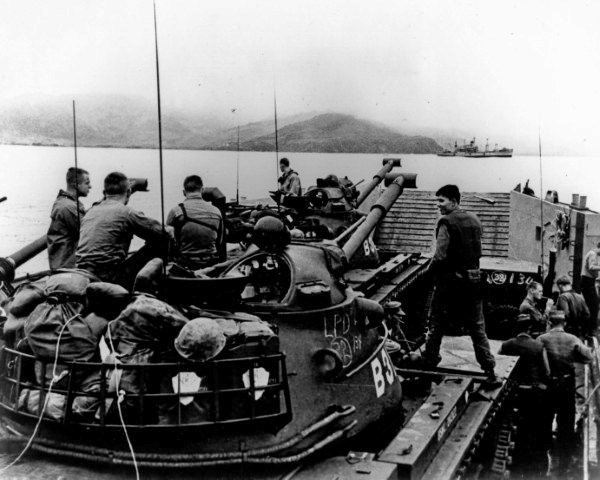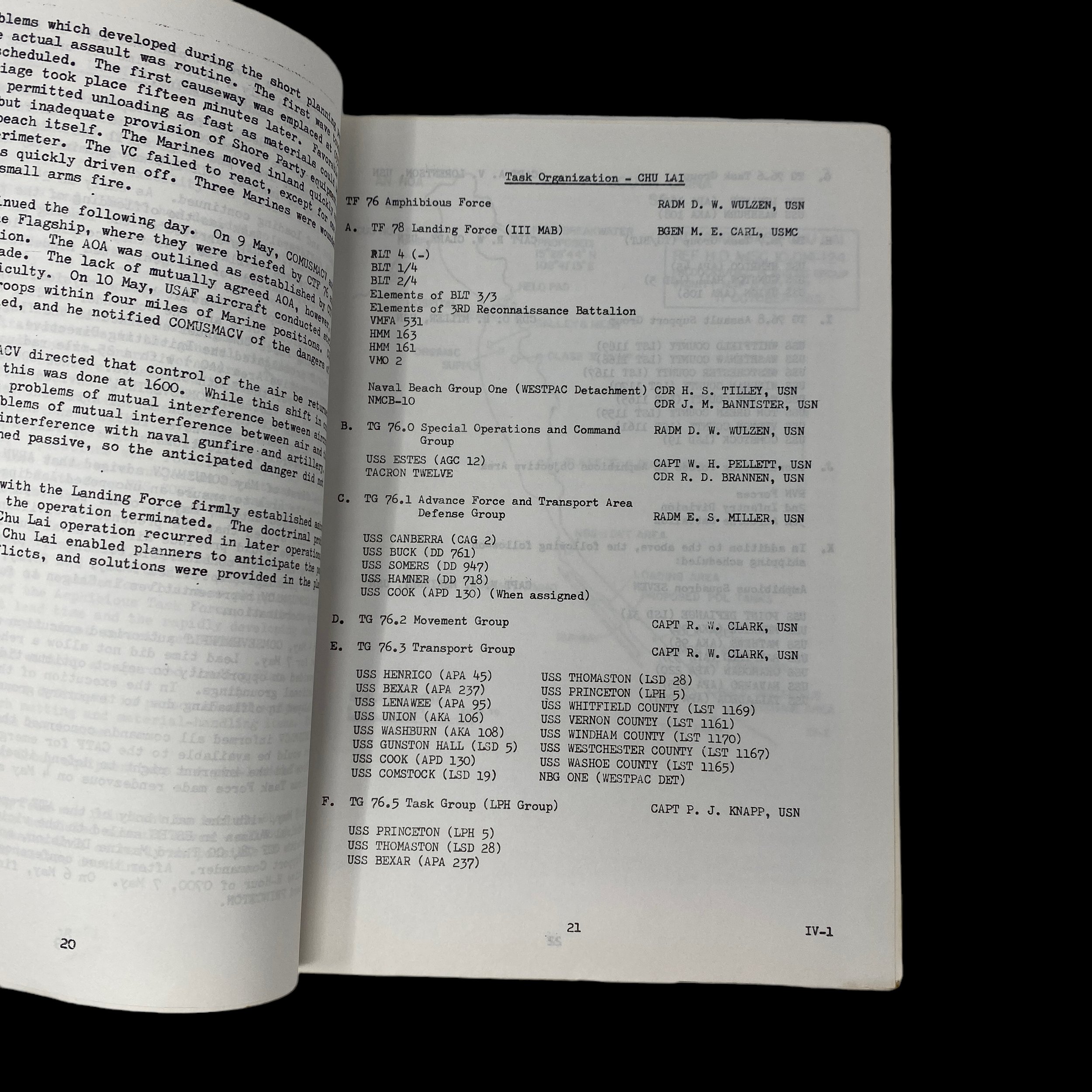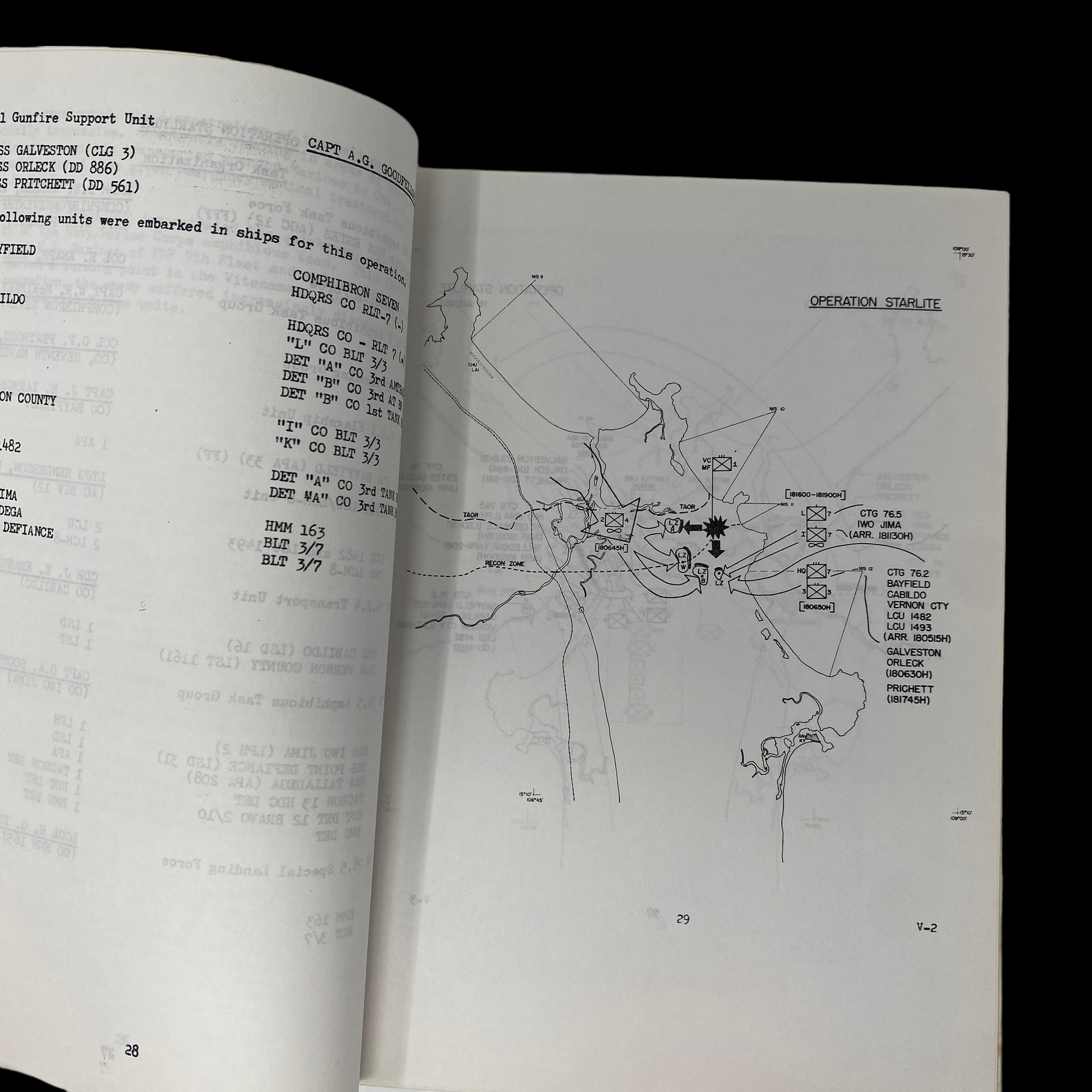VERY RARE! Vietnam War “CONFIDENTIAL” Amphibious Operations in South Vietnam March 1965 to December 1966 DETAILED Operations Report


































VERY RARE! Vietnam War “CONFIDENTIAL” Amphibious Operations in South Vietnam March 1965 to December 1966 DETAILED Operations Report
Comes with hand-signed C.O.A.
This incredibly rare and museum-grade Vietnam War artifact titled “History of Amphibious Operations in South Vietnam March 1965 - December 1966” was produced under the direction of the “Commander Amphibious Force United States Seventh Fleet”. Stamped multiple times as “CONFIDENTIAL” this special clearance operations report provided very sensitive and SECRET information of U.S. operations during 1965-1966. An extremely limited printing of these operations reports we produced making this a very rare operations report.
This 135-page operations report features unseen details of amphibious missions and operations. This report features many operations maps to accompany the missions and after-action reports. There are also various unseen and unpublished mission photos to accompany the reports as well.
This report features some incredible missions reports from OPERATION OSAGE, OPERATION DECKHOUSE, OPERATION DANANG, CHU LAI LANDINGS, DOUBLE EAGLE, HARVEST MOON, OPERATION JACKSTAY, OPERATION STARLITE OPERATION PIRANHA, and DAGGER THRUST.
The Special Landing Force In 1965
First established in 1960, the SLF deployed to South Vietnam with the very first deployment of American ground forces into Vietnam when BLT 2/9 (2d Battalion, 9th Marines) served as the reserve for the Marine landing at Da Nang in March 1965. In mid-April, the SLF was temporarily dissolved when its amphibious assets were required for the landing of the 3d Marine Amphibious Brigade (MAB) at the new base and airfield south of Da Nang - Chu Lai. However, Senior Marine and Navy commanders agreed the SLF should be reconstituted as soon as the necessary amphibious-capable shipping became available. On 19 June, Fleet Marine Force, Pacific, (FMFPac) reactivated the SLF. Its primary mission was to conduct amphibious raids to reduce enemy infiltration by sea and disrupt the buildup of enemy forces along the coast of South Vietnam. (GB-65).
The next landing of the SLF was Operation STARLITE, the largest battle of the war to that date. In mid-August 1965, Marine intelligence believed the 1st Viet Cong Regiment was preparing to attack the new Marine air base at Chu Lai in Quang Tin province. Major General Lewis Walt, commander of the III Marine Amphibious Force (III MAF), developed his plan to launch a preemptive attack against the entrenched VC regiment. The enemy was located on the Van Tuong Peninsula, 10 miles south of Chu Lai. (See Fig. 1) The Marine amphibious assault would employ heliborne and amphibious assaults plus fire support from air, artillery, and naval gunfire along with rapidity of movement to achieve surprise. Pressed for infantry battalions, Gen Walt decided to use the SLF, which was, at that time, over 700 miles away at Subic Bay, the Philippines, as part of the multi-battalion attacking force. The BLT with the SLF was 3/7 commanded by LtCol Charles H. Bodley. The Tank Platoon – 3d Platoon (Rein), “B” Company, 1st Tank Battalion was led by 2dLt R.A. Stewart. The Antitank (Ontos) Platoon (Rein) was led by 2dLt Manfred Wood.
The Marines began moving into position in AOA on 17 August to confront the VC force of approximately 1,500 fighters armed with recoilless rifles and mortars. Marines commenced landing across the beach and inland by helicopter on 18 August. By early afternoon fighting became extensive. The Regimental Landing Team (RLT) Commander, Colonel Oscar Peatross, decided to commit the reserve SLF BLT 3/7, which had been offshore since about 0930 hours having just arrived from Subic Bay, PI.
Operation Starlite saw 51 Marines killed in the fight. 614 VC were KIA in the battle, which lasted until 24 August. Marine tanks and Ontos from various units played a major role in the overwhelming success of the operation. The BLT finished back loading on 24 August at 1930 hours and returned to Subic Bay. Although the infantry companies of the BLT were landed, its tanks (3/B/1TK) and Ontos (3/C/1AT) evidently were not: according to the 3/7 Command Chronology, “… the heavy weapons and equipment attachments of the BLT remained at sea off the area of operations.” (GB-65)(CC-3/7, 8/65) (FF-AR).
During July “BLT 2/7 relieved BLT 3/7, commanded by Lieutenant Colonel Leon Utter, in Qui Nhon, RVN on 7 July 1965. First Lieutenant John Warner was the Platoon Commander of the Second Platoon(-)(Rein), “B” Company, First Tank Battalion, First Marine Division (2/B/1stTk’s) and Lieutenant Harvey Schmitt was the Second Platoon Commander, Company “C”, First Antitank Battalion, First Marine Division (2/C/1AT’s).
In the fall of 1965, a series of five amphibious raids (Operation DAGGER THRUST I-V) were conducted by the SLF along the coast of central South Vietnam. Tanks from 2/A/1TK and Ontos from 2/A/1AT served as the armor component of the BLT (2/1). Results ranged from disappointing to modest. Overall, the assaults failed to achieve their objectives, which was the rapid exploitation of intelligence in order to make contact with large enemy units. (GB-65). In “Volume One – 1965” of “U.S. Marine Tanks and Ontos in the Vietnam War” tank and antitank participation – such as it was – in each of the five DAGGER THRUST operations is addressed in some detail.
Operation PIRHANA, with BLT 1/7 the SLF’s ground force with tanks and Ontos attached, took place 7-10 September 1965. It was an amphibious raid on the Batangan Peninsula, about 20 miles south of Chu Lai. Marine armor consisted of 1/B/1TK and 1/C/1AT. With this operation, the entire reinforced tank and Ontos platoons were landed by 0910 hours on the first day of the operation. Tanks and Ontos supported the infantry in seizing various objectives. The enemy had constructed tank traps on the roads, the largest measuring 20’ x 10’ x 8’ deep. Ontos also provided security for the battalion command post, while tanks served with the battalion mobile reserve. 178 VC were killed in the operation. Marine casualties included two KIA. (CC-1/5, 9/65). No Tankers or Ontos crewmen were casualties. In Volume One of “U.S. Marine Tanks and Ontos in the Vietnam War”, details of both tank and Ontos participation are addresses.
November 1965 saw the launch of the two-phased Operation BLUE MARLIN, a search and clear operation between the coast and Route 1 in the Da Nang – Chu Lai corridor. On 15 November, a combined force consisting of BLT 2/7 and the 3d South Vietnamese Marine Battalion landed on the beach about 15 miles north of Chu Lai. The force swept south to Chu Lai but encountered no enemy forces. A platoon each of tanks and Ontos (2/B/1TK and 2/C/1AT) were attached to 2/7 as elements of the BLT, but were unloaded administratively at Chu Lai later in the operation. (CC-2/7, 11/65).
The second phase of Operation BLUE MARLIN commenced on 16 November with BLT 3/3. The battalion landed south of Da Nang and moved north. The tanks were a platoon from C/3TK; Ontos were a platoon from B/3AT. As with Phase I, enemy contact was light. No Marines were killed on the operation. VC casualties were 25 KIA. At the end of the operation, 3/3 moved to Da Nang by amphibious shipping and helicopter. (GB-65)(CC-2/7, 11/65).
The SLF served as the reserve force during Operation HARVEST MOON (9 December – 19 December 1965). This was a multi-battalion Marine-ARVN operation in the Que Son Valley along the border of Quang Nam and Quang Tin provinces. The enemy was the same (now reconstituted, re-armed, better trained and equipped) VC regiment the Marines fought in Operation STARLITE.
THE SLF IN 1966
The first SLF operation of 1966 was DOUBLE EAGLE (28 January – 1 March) with BLT 2/3. The location was Quang Ngai and Binh Dinh provinces at the boundary of I and II Corps. A platoon each of tanks and Ontos (2/A/3TK and 2/A/3AT) were attached to the BLT. Casualties were light, with five friendly KIA. According to the command chronology, “at no time did the enemy stand and fight.” (CC-2/3, 1-2/66).